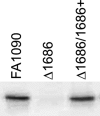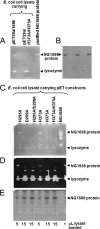Neisseria gonorrhoeae virulence factor NG1686 is a bifunctional M23B family metallopeptidase that influences resistance to hydrogen peroxide and colony morphology
- PMID: 22334697
- PMCID: PMC3322868
- DOI: 10.1074/jbc.M111.338830
Neisseria gonorrhoeae virulence factor NG1686 is a bifunctional M23B family metallopeptidase that influences resistance to hydrogen peroxide and colony morphology
Abstract
Symptomatic gonococcal infection, caused exclusively by the human-specific pathogen Neisseria gonorrhoeae (the gonococcus), is characterized by the influx of polymorphonuclear leukocytes (PMNs) to the site of infection. Although PMNs possess a potent antimicrobial arsenal comprising both oxidative and non-oxidative killing mechanisms, gonococci survive this interaction, suggesting that the gonococcus has evolved many defenses against PMN killing. We previously identified the NG1686 protein as a gonococcal virulence factor that protects against both non-oxidative PMN-mediated killing and oxidative killing by hydrogen peroxide. In this work, we show that deletion of ng1686 affects gonococcal colony morphology but not cell morphology and that overexpression of ng1686 does not confer enhanced survival to hydrogen peroxide on gonococci. NG1686 contains M23B endopeptidase active sites found in proteins that cleave bacterial cell wall peptidoglycan. Strains of N. gonorrhoeae expressing mutant NG1686 proteins with substitutions in many, but not all, conserved metallopeptidase active sites recapitulated the hydrogen peroxide sensitivity and altered colony morphology of the Δng1686 mutant strain. We showed that purified NG1686 protein degrades peptidoglycan in vitro and that mutations in many conserved active site residues abolished its degradative activity. Finally, we demonstrated that NG1686 possesses both dd-carboxypeptidase and endopeptidase activities. We conclude that the NG1686 protein is a M23B peptidase with dual activities that targets the cell wall to affect colony morphology and resistance to hydrogen peroxide and PMN-mediated killing.
Figures









Similar articles
-
Neisseria gonorrhoeae metalloprotease NGO1686 is required for full piliation, and piliation is required for resistance to H2O2- and neutrophil-mediated killing.mBio. 2013 Jul 9;4(4):e00399-13. doi: 10.1128/mBio.00399-13. mBio. 2013. PMID: 23839218 Free PMC article.
-
Natural compounds target the M23B zinc metallopeptidase Mpg to modulate Neisseria gonorrhoeae Type IV pilus expression.mBio. 2025 Apr 9;16(4):e0402724. doi: 10.1128/mbio.04027-24. Epub 2025 Feb 25. mBio. 2025. PMID: 39998224 Free PMC article.
-
Neisseria gonorrhoeae elicits extracellular traps in primary neutrophil culture while suppressing the oxidative burst.mBio. 2015 Feb 10;6(1):e02452-14. doi: 10.1128/mBio.02452-14. mBio. 2015. PMID: 25670773 Free PMC article.
-
Orthologous and Paralogous AmpD Peptidoglycan Amidases from Gram-Negative Bacteria.Microb Drug Resist. 2016 Sep;22(6):470-6. doi: 10.1089/mdr.2016.0083. Epub 2016 Jun 21. Microb Drug Resist. 2016. PMID: 27326855 Free PMC article. Review.
-
Defenses against oxidative stress in Neisseria gonorrhoeae: a system tailored for a challenging environment.Microbiol Mol Biol Rev. 2006 Jun;70(2):344-61. doi: 10.1128/MMBR.00044-05. Microbiol Mol Biol Rev. 2006. PMID: 16760307 Free PMC article. Review.
Cited by
-
Mating pair formation homologue TraG is a variable membrane protein essential for contact-independent type IV secretion of chromosomal DNA by Neisseria gonorrhoeae.J Bacteriol. 2013 Apr;195(8):1666-79. doi: 10.1128/JB.02098-12. Epub 2013 Feb 1. J Bacteriol. 2013. PMID: 23378511 Free PMC article.
-
Transcriptional regulation of a gonococcal gene encoding a virulence factor (L-lactate permease).PLoS Pathog. 2019 Dec 20;15(12):e1008233. doi: 10.1371/journal.ppat.1008233. eCollection 2019 Dec. PLoS Pathog. 2019. PMID: 31860664 Free PMC article.
-
Diversification of LytM Protein Functions in Polar Elongation and Cell Division of Agrobacterium tumefaciens.Front Microbiol. 2021 Aug 18;12:729307. doi: 10.3389/fmicb.2021.729307. eCollection 2021. Front Microbiol. 2021. PMID: 34489918 Free PMC article.
-
The Pathogenic Neisseria Use a Streamlined Set of Peptidoglycan Degradation Proteins for Peptidoglycan Remodeling, Recycling, and Toxic Fragment Release.Front Microbiol. 2019 Jan 31;10:73. doi: 10.3389/fmicb.2019.00073. eCollection 2019. Front Microbiol. 2019. PMID: 30766523 Free PMC article. Review.
-
The Neisseria gonorrhoeae type IV pilus promotes resistance to hydrogen peroxide- and LL-37-mediated killing by modulating the availability of intracellular, labile iron.PLoS Pathog. 2022 Jun 17;18(6):e1010561. doi: 10.1371/journal.ppat.1010561. eCollection 2022 Jun. PLoS Pathog. 2022. PMID: 35714158 Free PMC article.
References
-
- World Health Organization (2011) Emergence of multi-drug resistant Neisseria gonorrhoeae. Threat of global rise in untreatable sexually transmitted disease. in WHO/RHR/11.4 Department of Reproductive Health and Research, World Health Organization, Geneva
-
- Hook E. W., 3rd, Holmes K. K. (1985) Gonococcal infections. Ann. Int. Med. 102, 229–243 - PubMed
-
- Dokter W. H., Dijkstra A. J., Koopmans S. B., Stulp B. K., Keck W., Halie M. R., Vellenga E. (1994) G(Anh)MTetra, a natural bacterial cell wall breakdown product, induces interleukin-1 β and interleukin-6 expression in human monocytes. A study of the molecular mechanisms involved in inflammatory cytokine expression. J. Biol. Chem. 269, 4201–4206 - PubMed
-
- Melly M. A., McGee Z. A., Rosenthal R. S. (1984) Ability of monomeric peptidoglycan fragments from Neisseria gonorrhoeae to damage human fallopian-tube mucosa. J. Infect. Dis. 149, 378–386 - PubMed
Publication types
MeSH terms
Substances
Grants and funding
LinkOut - more resources
Full Text Sources
Medical
Molecular Biology Databases

